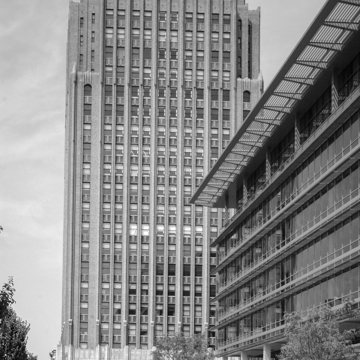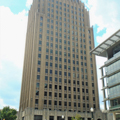You are here
The Tower at PPL Center
Rising twenty-four stories to a height of 322 feet, the Pennsylvania Power and Light Building (PP&L) is the Lehigh Valley's most prominent building and arguably the area's best. In the 1920s the valley's principal power company was housed in more than a dozen small offices. Befitting its commercial significance to Allentown and its desire to convey a modern image, PP&L conducted an architectural competition for its consolidated offices. The winner was the New York City firm that included Harvey Wiley Corbett. He had previously teamed with Hugh Ferriss to visualize the dramatic stepped-back forms for tall buildings in response to New York City's 1916 zoning laws. Along with Corbett, the principal designer was Wallace K. Harrison, who later was one of the architects of Rockefeller Center. The Allentown building was Harrison's first skyscraper. Looking back on his career, Harrison recalled the PP&L project in 1981: “It has always seemed to me to be the perfect illustration of why the skyscraper was the logical answer to the changing business scene in this country.” Ever the pragmatist, Harrison was perhaps unconsciously repeating remarks made at the opening of the building, when it was pointed out that “the monumental rather than the box type of building was justified by a careful study of the costs and all other factors entering into the cost of the project.” And, it was added, in the monumental form, that is, the skyscraper, “the architectural features are far superior.” The building was, of course, technologically sophisticated, with elevators that were, at the time, the fastest in the world, a distinction made more memorable by the fact that at first there were no doors, only wire gates. The PP&L Building soars upward, brick piers emphasizing the vertical line while setbacks at the top bring the bulk of the building to a climax. White limestone bas-relief detailing surrounding the main entrance is by Ukrainian-born Alexander Archipenko. It includes two eels pouring water over cog wheels to symbolize hydroelectric power. The building's contractor, Hegeman-Harris Company of New York City, had just completed the American Radiator Building in Manhattan. The PP&L Building was selected for the 1930 edition of the Encyclopedia Britannica to illustrate its entry on the modern tall office building. Recently refurbished and handsomely lit at night, the PP&L Building is the Lehigh Valley's crown jewel.
Writing Credits
If SAH Archipedia has been useful to you, please consider supporting it.
SAH Archipedia tells the story of the United States through its buildings, landscapes, and cities. This freely available resource empowers the public with authoritative knowledge that deepens their understanding and appreciation of the built environment. But the Society of Architectural Historians, which created SAH Archipedia with University of Virginia Press, needs your support to maintain the high-caliber research, writing, photography, cartography, editing, design, and programming that make SAH Archipedia a trusted online resource available to all who value the history of place, heritage tourism, and learning.
















